When planning the construction of a house, a summer residence, a bathhouse and other auxiliary structures on the site, many developers choose a pile-slab foundation. Bases of this type are difficult to manufacture, but have a number of unique performance characteristics. The combination of practicality, reliability and durability make the slab pile foundation the most popular construction in private construction. This support system has its own distinctive features, pros and cons, scope.
Description of the pile-slab foundation
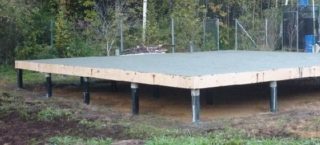
The pile-slab foundation is distinguished by the most complex device among the existing analogues. Therefore, they choose it when building on unstable soils and areas where there is a possibility of flooding. The finished base is so reliable that a heavy multi-storey building can be erected on it. The design feature lies in the distribution of ground loads through buried and surface elements. On the one hand, the stability of the structure is achieved due to the piles, on the other hand, the elimination of its subsidence due to the large area of the base plate on the pile foundation is achieved.
Structurally, the combined pile-slab foundation consists of the following parts:
- Backfill wells. The holes are made with a diameter of 20-40 cm, depending on the bearing capacity of the soil and the weight of the structure. A cushion of sand and gravel acts as a drainage and damper for ground vibrations.
- Piles. Bored supports are considered the most affordable and easy to create. Screw piles are more reliable, but their service life is limited by the metal's resistance to corrosion. The best option is reinforced concrete pillars. But here, too, there is a drawback - the rental of expensive equipment, with the help of which piles are driven or pressed into the ground.
- Plate. Prefabricated or monolithic on piles. In the first case, prefabricated concrete products are used. After laying, they are fastened together by welding and glue solution. A monolithic slab on screw piles is cast directly on site. Before filling the form, reinforcement is carried out with the creation of a common between the supports and the frame plate.
A separate item is waterproofing and insulation. A slab on reinforced concrete piles is cast and laid on a substrate of roofing material and foam, and the walls of the wells are finished with a roll of waterproof material.
Feasibility of application
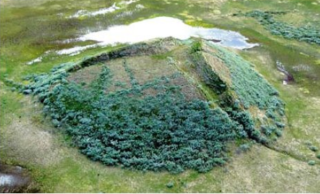
A common problem for all developers is to achieve the required degree of stability of buildings in unstable soils. In addition, engineers need to know and take into account the depth of freezing of the earth in the calculations. In a number of cases, when choosing a technology, a slab on piles, the foundation equally successfully transfers the difference in soil moisture and its freeze-thaw cycles.
Based on this, it is advisable to use this design in the following conditions:
- loose and weak soils;
- high groundwater level;
- swamps and peat bogs;
- high degree of frost heaving;
- the real risk of seasonal flooding;
- severe freezing of the earth during long winters;
- the impossibility of fragments of the pit due to the dense underground infrastructure;
- complex relief of the site;
- creation of an extension to the building on a strip base;
- seismic activity of the region;
- conducting low-rise construction in unexplored areas.
The lower part of the piles rests on dense soil layers, transferring the vertical load from the building to them. At the same time, single products tend to vibrate perceptibly, entering a state of resonance with the house. The foundation slab performs the function of an enlarged grillage, connecting all supports into a single system and extinguishing all vibrations.
Features of the pile-slab foundation
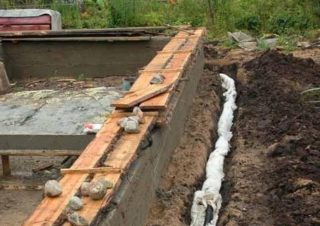
Pile-slab foundations are essentially a combination of pile and slab-type support systems. There are several types of such bases. The slab can be buried, surface and suspended. In turn, the connection of the fragments is carried out through reinforcement, heads and without adhesion, when the upper part is laid on the insulation on the supports.
The main advantages of the technology:
- Versatility. The structure can be installed on almost all types of soil, except for rocky, which cannot be drilled. The main thing is to achieve a dense layer.
- Effective counteraction up to the complete elimination of loads arising in the process of soil heaving.
- The ability to conduct construction on the bottom of reservoirs, uneven areas and slopes, arrangement of extensions to previously erected buildings without the risk of weakening their foundations.
- Reduction or absence of earthworks associated with tearing off the pit, leveling the site and removing the land.
Cons of combined support systems:
- The lack of the possibility of arranging the basement. Any such actions violate the stability and integrity of the pile field.
- Duration of construction, since each stage is associated with waiting for the target date for concrete to gain strength.
- High cost. It is often required to rent special equipment and workers. Quite high costs for the purchase and transportation of building materials, insulation and waterproofing.
- Dependence on weather conditions. Wet work should not be carried out at negative temperatures and during rain.
Nevertheless, pile-slab technology is becoming more and more in demand, both in low-rise and industrial construction.
DIY erection technology
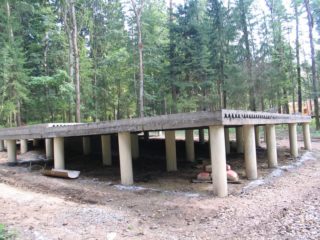
When self-erecting a building, you first need to obtain data on the properties of the soil, then carry out calculations and draw up drawings of both structural elements.
The construction of a pile-slab foundation consists of the following stages:
- Preparatory work. To begin with, the territory is cleared of debris, vegetation, auxiliary structures and design elements. After that, the place where the house will be is determined, and the markings are carried out. If combined technology is used, a pit for the slab is dug. The bottom of the pit is leveled and compacted. The final phase of preparation is the designation of the places where the supports will be.
- Installation of piles. During construction with their own hands, screw or bored piles are used. Supports with blades are screwed into the ground until the specified depth is reached. If necessary, they are built up. After that, the excess pipes are cut off, and concrete is poured into them. When installing bored piles, boreholes are first made using a hand or power drill. Then a removable or permanent formwork is inserted into the holes. It can be twisted roofing material, pipes made of plastic, metal or asbestos cement. A volumetric frame is inserted into the formwork, and only then it is filled with concrete filled with fine gravel.
- Pouring the slab. The most effective method is considered to be a sliding mount on the head of the ax. This design provides sufficient strength in combination with mobility and blocking dampness and cold from the supports. Geotextile is laid at the bottom of the pit, then waterproofing.After that, layers of sand and gravel are filled up, insulation is placed. Then the formwork and frame are assembled. Its height should be 3-5 cm below the fill level and 3-5 cm from the bottom. It is necessary to fill the formwork with mortar continuously or at minimal intervals.
Construction can be continued no earlier than 28 days later, when the concrete will gain full strength.
Some nuances
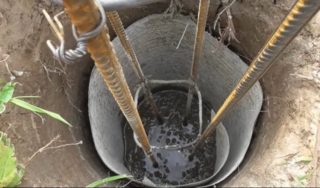
When manufacturing a slab-pile foundation, it is recommended to adhere to the following rules:
- draw up a diagram so that the distance between the supports does not exceed 200 cm;
- install supports at corners, along the perimeter and at the junction of external walls and partitions;
- knit reinforcement with wire, since the metal loses its strength and rusts from welding;
- when making bored piles, always use waterproofing so that water from the solution does not go into the soil;
- when planning the foundation, always leave a margin of safety for the addition of new levels to the building.
In all cases, if possible, specialists should be invited to conduct geological exploration.
Preservation of the vertical position of the building, resistance to changes in the state of the soil and uniform distribution of pressure depend on the correct arrangement of the support system. It is the foundation that determines the service life of any property. That is why the cost of erecting the support system is up to 40% of the total estimate.








